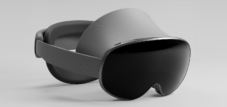Published on: April 1, 2025 / update from: April 1, 2025 - Author: Konrad Wolfenstein

VR glasses Vivo Vision: The new challenger in the mixed reality market-image template: Vivo / creative image: Xpert.digital
The smartphone giant relies on the future: Vivo Vision in focus
Vivo Vision: The new challenger in the mixed reality market
Vivo recently announced its introduction to the growing mixed reality technology with the vivo vision-a headset that causes a sensation not only by its name, but also through its strikingly familiar design. The prototype was presented at the Boao Forum for Asia and marks a strategic step by the Chinese smartphone manufacturer in new technology areas. Although detailed technical specifications are still standing, the presentation Vivos shows ambitious plans in the area of spatial data processing and robotics.
The design: more than just inspired
The Vivo Vision is characterized by a design that observers immediately appears known. The similarity to the Apple Vision Pro is so pronounced that many experts call it a direct clone. The headset has gray fabric padding on the front, an identically designed rear belt and an external battery that is connected to the device via a cable. Even the name “Vision” and the use of the term “spatial computing” in marketing communication were adopted by Apple.
The black glass front in the style of ski goggles houses several cameras that are probably intended for the tracking and hand gesture recognition. The only striking difference to the Apple counterpart is the side arms of the headset, which are shiny with metallic instead of white.
Also striking is the magnetic connection to connect the battery to the headset, which has an amazing resemblance to Apple's solution - both in the construction and in the button -like design. However, the Vivo Vision's visor front appears slimmer than that of the Vision Pro, which indicates a possibly lower weight.
Suitable for:
Functionality and specifications
So far, Vivo has not published any technical specifications or details on the functionality of the headset. It is not even clear whether there is already a functional prototype because nobody outside the company had the opportunity to test the device. It also remains unclear whether the headset will work independently or whether it must be connected to a computer.
The missing information raises questions: Which hardware drives the Vivo Vision? Which operating system will use it? How long does the battery last? These and other important details are expected to be announced only at the official presentation in mid -2025.
Strategic importance for vivo
The presentation of the Vivo Vision goes beyond the mere introduction of a new product - it marks a strategic change of direction for the company. At the same time as the presentation of the headset, Vivo announced the establishment of its own robotics laboratory.
HU Baishan, Executive Vice President and Chief Operating Officer at Vivo, explained that the smartphone industry was a microcosm of technological innovation in China and the development of Vivo reflects the progress of this sector. The company wants to combine its many years of experience in areas such as AI learning models and imaging with the spatial data processing skills of the Vivo Vision to develop the “brain” and “eyes” of robots.
Vivo imagines a future in which robotics enriches daily life and works to bring robots to the households of consumers worldwide together with partners from industry. This vision shows that Vivo sees the mixed reality headset as part of a more comprehensive technology strategy that goes beyond VR and AR applications.
Market classification and competitive environment
Vivo's entry into the mixed reality market takes place at a time when several large technology companies expand their positions in this area. With the Vision Pro, Apple has put the bar for mixed reality technology up, but at a price of around EUR 3,500 (approx. EUR 3,000), which limits mass acceptance.
Samsung works in cooperation with Google and Qualcomm on an Android XR headset (project name “Moohan”), which is expected to be presented in 2025. Meta is currently dominating the market for more affordable VR headsets with its quest 3.
Although Vivo is silent at the prices of his headset, it is speculated that the company-similar to its smartphones-could be positioned in medium to upper price segment, possibly at a cheaper price than comparable high-end models. This strategy could give the vivo vision a competitive advantage, especially in regions in which both the vision and competing products will be available.
Suitable for:
- Apple has stopped production of the Vision Pro - is that the end or is the Vision Pro 2 coming? A step back for the big leap forward?
Availability and future prospects
The prototype of the Vivo Vision is to be officially presented in mid -2025. So far there is no information about whether the headset outside China and selected Asian markets will be available. This regional restriction could be an essential factor that influences the global competitiveness of the product.
At least in China, Vivo could take a strong position in the MR market with the vision. The company is already one of the leading smartphone manufacturers on the Chinese market and has a wide user base of over 500 million people in more than 60 countries worldwide.
Technological perspectives and innovation potential
Although the details of the Vivo Vision are still sparse, the connection to the company's robotics initiative indicates interesting future applications. The combination of spatial data processing, AI and imaging technologies could not only be used for Immersive VR/AR experiences, but also for the development of household robots and other intelligent assistance systems.
The “Blue Technology Matrix” mentioned by Vivo is intended to improve the integration between the digital and physical world. This vision goes beyond traditional mixed reality applications and shows that Vivo thinks in the long term-with the vision headset as a component in a larger technological ecosystem.
From smartphones to mixed reality: the future strategy of vivo
The Vivo Vision marks the ambitious entry of another large technology company into the mixed reality market. While the design was unmistakably inspired by the Apple Vision Pro-or even copied-it remains to be seen whether vivo can convince with innovative functions, competitive prices and convincing integration into its wider technology ecosystem.
The connection to the company's robotics initiative indicates a long-term vision that goes beyond simple VR/AR applications. If Vivo succeeds in successfully transferring its know-how in the areas of smartphone technology, AI and image processing to mixed reality and robotics, the company could play an important role in the next phase of technological evolution.
With the official presentation of the Vivo Vision planned for mid -2025, we will learn more about the technical specifications, pricing and market positioning. Until then, the headset remains a fascinating, albeit puzzling example of the increasing convergence of different technology areas - and for intensive competition in the emerging market for spatial computing.
Suitable for:
Your global marketing and business development partner
☑️ Our business language is English or German
☑️ NEW: Correspondence in your national language!
I would be happy to serve you and my team as a personal advisor.
You can contact me by filling out the contact form or simply call me on +49 89 89 674 804 (Munich) . My email address is: wolfenstein ∂ xpert.digital
I'm looking forward to our joint project.













